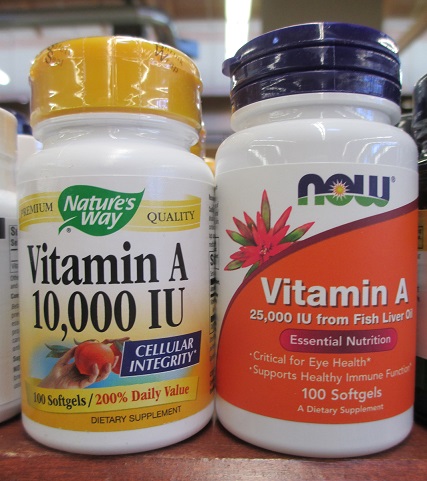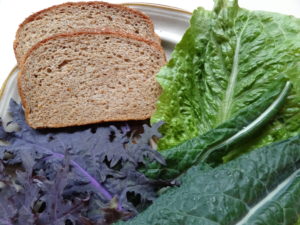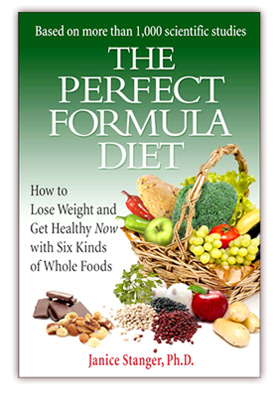
Be alert – it’s legal to sell vitamin A supplements in doses that are higher than the recommended daily upper limit
Too Much Vitamin A Can Lead to Weak Bones and Fractures
Vitamin A is essential for proper vision, allowing new cells to form, and supporting reproduction and growth (including immune system strength). Sounds wonderful, you may be thinking, and decide to consume large amounts of vitamin A. There’s a problem with this strategy though – vitamin A is fat soluble, accumulating in your liver and fat cells when you eat more than you currently need. At high levels, this stored vitamin A exceeds your body’s tolerable level, and starts causing significant harm.
You ingest vitamin A in two main forms:
- Preformed vitamin A, which is this vitamin in a form that it can be directly used by your body. You get preformed vitamin A from animal foods (especially liver, fish liver oils, dairy products, and eggs). Some “fortified” foods, multivitamins, and some other supplements also may contain preformed vitamin A.
- Carotenoids, pigments in many plant foods, that your body converts to vitamin A through a regulated process. The carotenoid that your body most easily changes to vitamin A is beta-carotene.
Nutritionists have developed a couple rather complex ways of determining how much vitamin A you need, whether from preformed sources or carotenoids. Rather than wading through all the complexities, it’s easiest to just think in term of IUs (International Units), which are commonly used. The recommended dietary allowance (RDA) for vitamin A daily is 3,000 IU for men, 2300 IU for women, with other amounts for infants and children. The daily upper level of intake, which should not be exceeded, is 10,000 IUs.
Vitamin A Toxicity
Vitamin A toxicity comes from eating too much preformed vitamin A from animal foods, fortified foods, and/or supplements. This can happen quickly from a single large dose, which results in acute vitamin A toxicity. Symptoms of this condition include nausea, headache, fatigue, loss of appetite, dizziness, dry skin, and brain swelling.
Much more common, however, is chronic vitamin A toxicity from consuming a bit too much preformed vitamin A over a longer period of time. You do not need to eat more than the upper level of intake for this to happen – you only have to eat more
preformed vitamin A than you need. The threshold to develop this condition varies among different individuals. Remember, this vitamin accumulates in the liver and other fatty tissues, and your body has no good way to get rid of it. This is especially dangerous in pregnant women, as too much vitamin A in the mother’s body during pregnancy can lead to serious birth defects in the baby.
If you are not pregnant, vitamin A toxicity will likely show itself as weak bones that are prone to fracture (although other symptoms may be present in many parts of your body). Vitamin A suppresses normal bone-building and speeds bone breakdown. Many research studies have found that vitamin A interferes with the action of activated vitamin D in your intestines. Usually activated vitamin D (which the body makes as needed from the relatively inert vitamin D circulating in your blood) causes the intestines to absorb more calcium when needed. Excess vitamin A competes with the activated vitamin D, with the result that you don’t absorb as much calcium as you need.
The Paleo diet, which revels in eating liver, is especially hazardous, as liver is the food with the highest concentration of preformed vitamin A. Paleo bloggers often tout this danger as if it were a good thing, and dismiss the known hazards. Dairy products and eggs are not slackers in this regard either – these foods also have significant amounts of the preformed vitamin.
What About Too Many Carotenoids?
Deep green and orange, yellow, and red vegetables and fruits are crammed with carotenoids. Think apricots, cantaloupe, mangoes, nectarines, red and orange peppers, carrots, sweet potatoes, pumpkin, spinach, broccoli, and kale, among many

Dark leafy greens, such as kale, have lots of carotenoids, which your body can transform into vitamin A when you need it. The best diet has a variety of whole plant foods, and does not focus too much on one or a few nutrients
other excellent foods. The carotenoids are best absorbed if you eat them with small amounts of whole plant foods, such as nuts, seeds, avocados, or olives, that are higher in fat. Always avoid extracted oils.
Most beta-carotene and other carotenoids in food are not converted to vitamin A. Your body closely regulates this process so you don’t make more than you need, and stores extra carotenoids in fat under your skin. This can give your skin an orange or yellow hue, which is not generally harmful. These food carotenoids are valuable antioxidants that protect your cells (while vitamin A has no antioxidant activity).
One medical journal article did report the case of “carrot man,” who reported he had been eating six to seven pounds of carrots every week to try to lose weight. Even at this high amount, his main symptom was a mild abdominal discomfort and elevated liver enzymes; after he stopped eating so many carrots, his symptoms quickly went away. The bottom line: eat a varied whole foods, plant-based diet, with lots of deep green and orange, yellow, and red fruits and veggies. Don’t overload on any one food to the point you are eating several pounds of it every week.
Carotenoid supplements are another story. Because these factory-made substances contain one or a few isolated carotenoids in doses far higher than any whole foods would have, supplements with carotenoids can be dangerous. With this level of overconsumption, carotenoids can flip from being antioxidants to prooxidants, damaging your cells and destroying vitamin A. Studies have found that carotenoid supplements may promote cancer, especially in smokers and people who drink a lot of alcohol.

Persimmons are a lovely orange fruit crammed with carotenoids that your body can use as an antioxidant, or make into vitamin A if you need it
The bottom line is, that to avoid vitamin A toxicity, minimize or totally avoid eating animal foods, especially all liver and fish liver oils, eggs, and dairy products (including milk, cheese, and butter). Avoid supplements with vitamin A or carotenoids, unless prescribed by your doctor for a diagnosed medical condition. Check the label of fortified foods to see if added vitamin A is listed as an ingredient. If so, you should minimize these choices as well. If the food satisfies vitamin A requirements with whole plant foods (for example, the vitamin A content in a package of chopped tomatoes), this is fine and you don’t have to worry. Enjoy.
If you enjoyed this article, you may want to read more on Vitamin D (another fat soluble vitamin) and the benefits of sunshine.
Intrigued? Now you can use our Whole Foods Blog Finder to target informative, fun postings on whole foods, plant-based diets. Quick information at no cost!
Post written by Janice Stanger, Ph.D. Janice authored The Perfect Formula Diet: How to Lose Weight and Get Healthy Now With Six Kinds of Whole Foods. This book will show you a whole foods, plant-based eating plan with lots of carotenoids and no need for dangerous preformed vitamin A.
Tags: carotenoids, liver, Paleo diet dangers, supplements, vitamin A, vitamin A toxicity, whole foods plant-based diet





